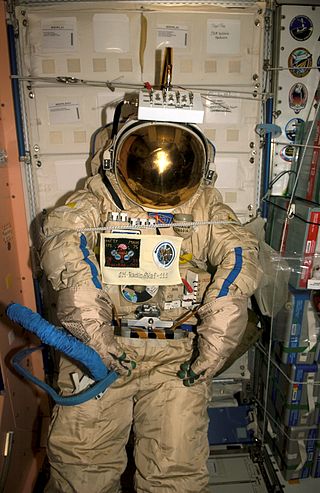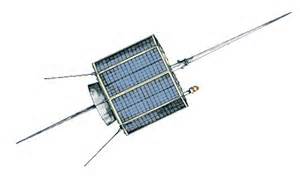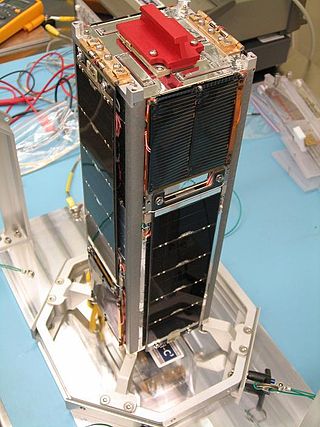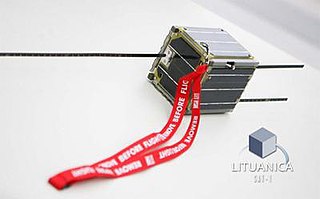Mission

Fox-1Cliff was launched on 3 December, 2018 via Falcon 9 Block 5 from Vandenberg Air Force Base, California, United States. [3]
Receiver failure
Shortly after deployment, AO-95's receiver suffered a failure due to unknown reasons. [4]
| Mission type | Communications |
|---|---|
| Operator | AMSAT |
| COSPAR ID | 2018-099N |
| SATCAT no. | 43770 |
| Spacecraft properties | |
| Launch mass | 1.3 kg (2.9 lb) |
| Dimensions | 10 cm × 10 cm × 10 cm (3.9 in × 3.9 in × 3.9 in) |
| Start of mission | |
| Launch date | 3 December 2018, 13:34 UTC |
| Rocket | Falcon-9 v1.2 (Block 5) |
| Launch site | Vandenberg SLC-4E |
| Contractor | SpaceX |
| Orbital parameters | |
| Reference system | Geocentric |
| Regime | Low Earth |
| Semi-major axis | 6,960 kilometres (4,320 mi) |
| Eccentricity | 0.0013176 |
| Perigee altitude | 580.6 kilometres (360.8 mi) |
| Apogee altitude | 599 kilometres (372 mi) |
| Inclination | 97.7217° |
| Period | 96.3 minutes |
| RAAN | 108.0793° |
| Argument of perigee | 289.6601° |
| Mean motion | 14.94902621 |
| Epoch | 3 February 2020 |
Fox-1Cliff, AO-95 or AMSAT OSCAR 95 is an American amateur radio satellite. Fox-1Cliff is a 1U CubeSat built by AMSAT-NA that carries a single-channel transponder for mode U/V in FM. [1]
The satellite carries several student experiments: [2]
It also carries a VGA camera provided by Virginia Tech.

Fox-1Cliff was launched on 3 December, 2018 via Falcon 9 Block 5 from Vandenberg Air Force Base, California, United States. [3]
Shortly after deployment, AO-95's receiver suffered a failure due to unknown reasons. [4]
The satellite is the third of five Fox-1 satellites, and was originally named Fox-1C. In 2016, it was renamed Fox-1Cliff in honor of Cliff Buttschardt, a long time member of AMSAT and a contributor to the project, who died earlier that year. [5] After its launch, Fox-1Cliff was renamed AO-95.
AMSAT is a name for amateur radio satellite organizations worldwide, but in particular the Radio Amateur Satellite Corporation (AMSAT) with headquarters at Washington, D.C. AMSAT organizations design, build, arrange launches for, and then operate (command) satellites carrying amateur radio payloads, including the OSCAR series of satellites. Other informally affiliated national organizations exist, such as AMSAT Germany (AMSAT-DL) and AMSAT Japan (JAMSAT).

AMSAT-OSCAR 51 or AO-51 is the in-orbit name designation of a now defunct LEO amateur radio satellite of the OSCAR series; formerly known as ECHO, built by AMSAT. It was launched on June 29, 2004 from Baikonur Cosmodrome, Kazakhstan on a Dnepr launch vehicle. It is in sun synchronous low Earth orbit.
HAMSAT also known as HAMSAT INDIA, VU2SAT and VO-52 is a microsatellite weighing 42.5 kilograms (93.7 lb), providing amateur radio satellite communications services for Indian and international amateur radio operators. This satellite carries the in-orbit designation of VO-52, and is an OSCAR series satellite.

SuitSat was a retired Russian Orlan space suit with a radio transmitter mounted on its helmet, used as a hand-launched satellite.

AMSAT-OSCAR 7, or AO-7, is the second Phase 2 amateur radio satellite constructed by the Radio Amateur Satellite Corporation or AMSAT. It was launched into Low Earth Orbit on November 15, 1974 and remained operational until a battery failure in 1981. After 21 years of apparent silence, the satellite was heard again on June 21, 2002 – 27 years after launch. At that time the public learned that the satellite had remained intermittently functional and was used surreptitiously for communication by the anticommunist opposition Fighting Solidarity during martial law in Poland.

Delfi-C3 is a CubeSat satellite constructed by students at the Delft University of Technology in the Netherlands. It is a 3-unit CubeSat, and was launched at 03:53:42 on 28 April 2008, as part of the NLS-4 mission, aboard a PSLV rocket, from the Second Launch Pad at the Satish Dhawan Space Centre in India. The launch was contracted by ISRO, through Antrix Corporation and UTIAS.

Compass-1 is a German amateur CubeSat picosatellite, built and operated in the late 2000s by Aachen University of Applied Science. It was launched by the Indian Space Research Organisation, aboard a PSLV rocket as a secondary payload to the CartoSat-2A primary spacecraft on 28 April 2008. It was launched into a Geocentric orbit with an altitude of 597 km. Its primary mission is remote sensing; however, it also contains some technology demonstration experiments regarding the use of small satellites and GPS tracking.
AMSAT-OSCAR 16, also known as AO-16 and PACSAT, is the in-orbit name designation of an amateur radio satellite of the OSCAR series. It was built by AMSAT and was launched on 22 January 1990 from Kourou, French Guiana on an Ariane 4 launch vehicle. It is in sun synchronous low Earth orbit.
Saudi-OSCAR 50 is a Saudi Arabian amateur radio satellite that was launched on 20 December 2002 by the King Abdulaziz City for Science and Technology.
An amateur radio satellite is an artificial satellite built and used by amateur radio operators. It forms part of the Amateur-satellite service. These satellites use amateur radio frequency allocations to facilitate communication between amateur radio stations.

LituanicaSAT-1 was one of the first two Lithuanian satellites. It was launched along with the second Cygnus spacecraft and 28 Flock-1 CubeSats aboard an Antares 120 carrier rocket flying from Pad 0B at the Mid-Atlantic Regional Spaceport on Wallops Island to the International Space Station. The launch was scheduled to occur in December 2013, but later was rescheduled to 9 January 2014 and occurred then. The satellite was broadcasting greetings of Lithuanian president, Mrs. Dalia Grybauskaitė. The satellite was deployed from the International Space Station via the NanoRacks CubeSat Deployer on February 28, 2014. All LituanicaSAT-1 subsystems have been turned on, tested and proved to be working properly. The mission is considered a complete success by its team of engineers. The mission ended upon the reentry and disintegration of the satellite on July 28, 2014.

FUNcube-1 is a complete educational single unit CubeSat satellite with the goal of enthusing and educating young people about radio, space, physics and electronics. It is part of a program which aims to launch more of these educational CubeSats. It is the first satellite with outreach as its primary mission.
UBAKUSAT was a Turkish nanosatellite that was developed by Istanbul Technical University. It was launched into space on board a Falcon-9 rocket in April 2018 and was deployed into its orbit from the International Space Station in May 2018. It was built as a technology demonstration and earth observation satellite to provide voice communications for amateur radio stations around the world. It carried an experimental card, TAMSAT Simplesat, which allowed scientists to test its accuracy of measuring radiation from space. It was the fifth satellite to be built by students of Istanbul Technical University.
Fox-1D, AO-92 or AMSAT OSCAR 92 is an American amateur radio satellite. Fox-1D is a 1U CubeSat developed and built by AMSAT-NA. Fox-1D carries a single-channel transponder for mode U/V in FM. Fox-1D has an L-band converter, which allows the FM transponder to be switched on an uplink in the 23 centimetres (9.1 in) band.
Fox-1B, AO-91 or AMSAT OSCAR 91 is a United States amateur radio satellite. It is a 1U Cubesat, was built by the AMSAT-NA and carries a single-channel transponder for FM radio. The satellite has a whip antenna for the 70 cm and 23 cm bands (uplink), and a second antenna for the 2 m band (downlink). Fox-1B is the second amateur radio satellite of the Fox series of AMSAT North America.
Fox-1A, AO-85 or AMSAT OSCAR 85 is an American amateur radio satellite. It is a 1U Cubesat, was built by the AMSAT-NA and carries a single-channel transponder for FM radio. The satellite has one rod antenna each for the 70 centimetres (28 in) and 2 metres bands. To enable a satellite launch under NASA's Educational Launch of Nanosatellites (ELaNa) program, the satellite continues to carry a Penn State University student experiment.

HuskySat-1 is an artificial satellite designed at the University of Washington. It was launched by Cygnus NG-12 from Mid-Atlantic Regional Spaceport Launch Pad 0 on Wallops Island, Virginia to low earth orbit on November 2, 2019. It is a CubeSat, and will demonstrate onboard plasma propulsion and high gain telemetry for low Earth orbit that would be a precursor for an attempt at a larger CubeSat designed for orbital insertion at the Moon.
Eyesat-1 is an American experimental communications microsatellite with an store-dump payload. The mission of Eyesat-1 was experimental monitoring of mobile industrial equipment. Eyesat-1 has provided the National Oceanic and Atmospheric Administration in Silver Spring, Maryland, with communication services to the South Pole. Eyesat-1 carries an FM repeater for Amateur Radio Research and Development Corporation (AMRAD) called AMRAD OSCAR 27 or OSCAR 27.
Fox-1E, AO-109, Evolution or AMSAT OSCAR 109 is an American amateur radio satellite. It is a 1U Cubesat, was built by the AMSAT-NA and carries a single-channel transponder for FM radio. Fox-1E is the fifth amateur radio satellite of the Fox series of AMSAT North America.
HADES, Spain-OSCAR 115 or SO-115, is a Spanish amateur radio satellite.